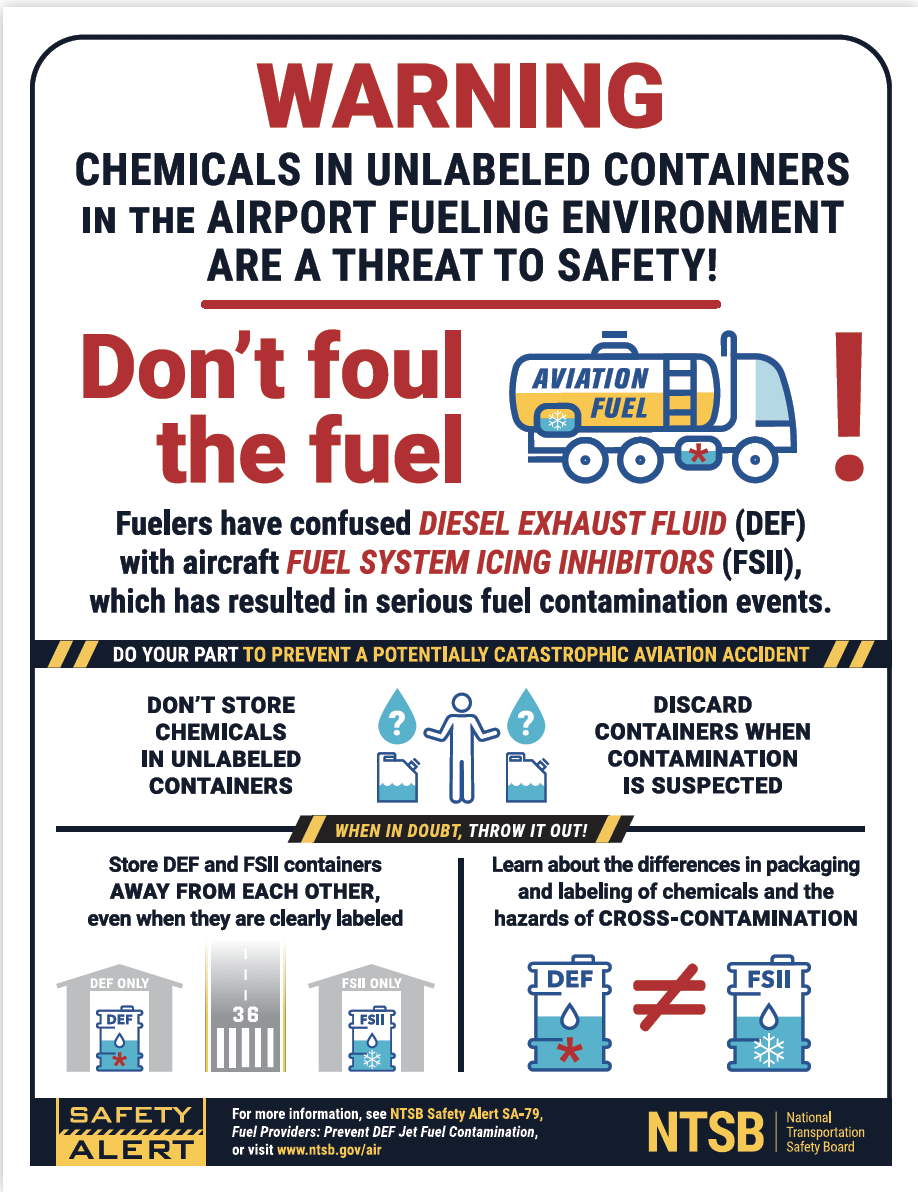Diesel exhaust fluid (DEF) is a urea-based chemical that is added to ground vehicle emissions systems
to reduce nitrogen oxide (NOx) emissions. DEF is not designed, nor approved, for use in jet fuel.
If it is inadvertently added to jet fuel, as has happened in several incidents over the last 2 years, DEF will
react with certain chemical components to form crystalline deposits in the fuel system. The crystalline
deposits can then accumulate on filters, engine fuel nozzles, and fuel metering components and result
in a loss of engine power.
In January 2010, the Environmental Protection Agency began requiring reduced NOx emissions from
on-road medium and heavy-duty diesel vehicles. In 2014, all-new off-road vehicles, including airport
refueling trucks, were required to meet these standards. As a result, all diesel vehicle manufacturers
now use a selective catalytic reduction system and DEF to reduce harmful emissions.
Because the use of DEF is now required for all new off-road vehicles, its presence on airport property is
becoming more prevalent as refueling trucks are replaced.
DEF can be mistaken for other clear, colorless liquids, such as fuel system icing inhibitors (FSII). Both
products can be purchased in bulk and transferred to smaller containers for ease of use. Both are
usually stored in milky white containers. Also, airport refueling trucks are serviced with both products.
In a May 2019 incident that the NTSB is investigating, a Cessna C550
experienced a total loss of engine power to both engines while on an air
medical flight. The crew diverted to a nearby airport and safely landed
the airplane. The two airline transport pilots, two medical crew, and
three passengers were not injured. An airport lineman later reported
that the day before the incident, he had combined two partially filled
containers; one contained FSII and the other contained DEF, which he
had mistaken for FSII. He then added the combined fluid to the truck’s
FSII reservoir. The following day, the incident airplane was fueled with
480 gallons of Jet A fuel with FSII additive mixed at the time of fueling.
Analysis of fuel samples, fuel system filters, and fuel screens from the
airplane indicated the presence of urea, the primary chemical found in
DEF. (ERA19IA178)
Although not investigated by the NTSB, two other incidents have
occurred that resulted from the inadvertent introduction of DEF into
aircraft fuel tanks by way of a refueling truck FSII reservoir.
• In November 2017, at Eppley Airfield, Omaha, Nebraska, seven aircraft
had DEF directly injected and six aircraft were refueled with equipment
that was exposed to DEF.
• In August 2018, at Miami-Opa Locka Executive Airport, Opa-Locka,
Florida, five aircraft had DEF directly injected and nine aircraft were
refueled with equipment exposed to DEF.
At both airports, all 12 aircraft that were directly exposed to DEF
experienced service difficulties and unplanned diversions resulting
from clogged fuel filters and fuel nozzle deposits (see the special
airworthiness information bulletins [SAIBs] listed below for more
information).
What can fuel providers do?
Because bulk fluids and chemicals are generally stored in the same
areas, use the following tips to prevent confusion:
Do not store or temporarily place chemicals into unlabeled containers;
always use containers and labels that meet OSHA requirements.
Ensure that all containers (including bulk storage tanks and larger cube
tanks) are clearly marked with 4-inch or larger stenciled letters visible from
all sides. Use “DIESEL EMISSION FLUID (DEF)” for all DEF fluid and “JET
FUEL SYSTEM ICIING INHIBITOR” for all FSII storage containers.
Add a label to all DEF containers that say, “NOT FOR AVIATION USE.”
Even when the containers are clearly marked, do not store DEF and FSII
close to each other since it is hard to differentiate the clear, colorless
liquids.
All staff should be trained on the storage locations of DEF and FSII, the
packaging and labeling of both chemicals, and the hazards associated with
DEF fuel contamination.
Fueling agents or operators should remove from aircraft and discard jet
fuel or FSII suspected of being contaminated with DEF. Do not attempt to
repurpose DEF contaminated fuel or FSII to other aircraft or vehicles.
Review and consider implementing the recommendations contained within
the June 11, 2019, Aircraft Diesel Exhaust Fluid Contamination Working
Group Report.
The Federal Aviation Administration (FAA)
released SAIBs HQ-18-08R1 and HQ-18-28,
which cite the DEF contamination events from
2017 and 2018 discussed above and provide
more information on the hazards of DEF fuel
contamination.
The National Air Transportation Association’s
Safety 1st DEF Contamination Prevention Training
for line personnel, fixed-based operator general
managers, and customer service representatives
reviews storage, handling, and personnel training
procedures to prevent fuel contamination.
The FAA released Safety Alert for Operators
18015 in November 2018, which discusses the
safety concerns for aircraft serviced with jet fuel
contaminated with DEF and highlights its hazards
The NTSB is an independent federal agency charged by Congress with investigating every civil aviation
accident in the United States and significant accidents in other modes of transportation—highway, marine,
railroad, and pipeline. The NTSB determines the probable cause of the accidents and issues of safety
recommendations aimed at preventing future accidents. For more information, visit www.ntsb.gov.
*re-published from NTSB safety alert 79




